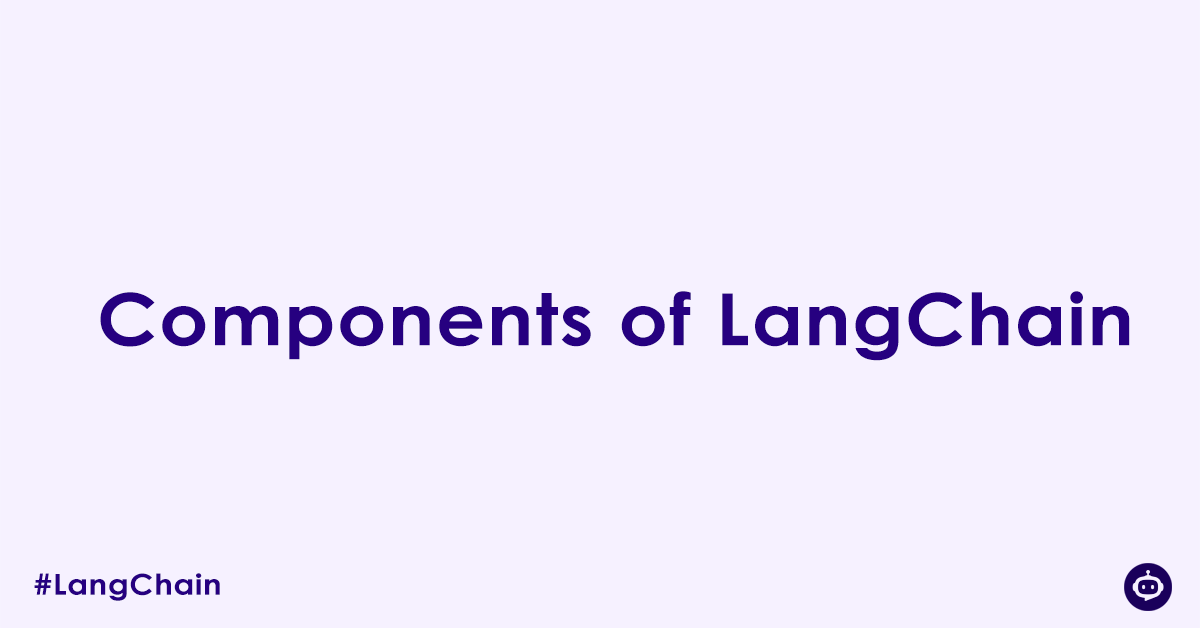As large language models (LLMs) like GPT-4 and Claude become increasingly powerful, developers are looking for robust ways to build intelligent, context-aware applications on top of them. This is where LangChain shines.
LangChain is a modular framework for developing applications powered by LLMs. It provides a rich set of building blocks—called components—that can be composed into advanced language workflows, from chatbots and AI agents to document summarizers and autonomous research tools.
In this post, we’ll break down LangChain’s core components, how they interact, and how you can use them to build scalable and intelligent AI systems.
🧱 The Core Components of LangChain
LangChain is built around composable modules, each responsible for a key part of the LLM application pipeline. These components are designed to be both modular (use only what you need) and interoperable (work well together).
Here’s a breakdown of the most important LangChain components:
1. LLMs (Large Language Models)
At the heart of LangChain is its integration with a variety of LLMs:
- OpenAI (GPT-4, GPT-3.5)
- Anthropic (Claude)
- Cohere
- Hugging Face models
- Google Gemini
- Local models (via Hugging Face Transformers or Ollama)
Purpose:
The LLM component wraps API calls to these models, allowing LangChain to interact with them in a uniform way.
Example:
from langchain.llms import OpenAI
llm = OpenAI(model_name="gpt-4")
2. Prompt Templates
Crafting prompts effectively is crucial when working with LLMs. LangChain provides a robust system for managing prompt templates, making it easy to reuse and format prompts dynamically.
Features:
- Templates with placeholders (e.g.,
{input}) - Support for system, human, and AI messages (in chat models)
- Integration with chains and agents
Example:
from langchain.prompts import PromptTemplate
prompt = PromptTemplate.from_template("What is a good name for a company that makes {product}?")
3. Chains
Chains are sequences of actions that automate a workflow. The most common type is an LLMChain, which combines a prompt and a model.
LangChain offers various chain types:
LLMChain: Simple input → prompt → LLM → outputSequentialChain: Multiple chains run in orderRouterChain: Chooses a chain based on inputRetrievalQA: Combines document retrieval and generation
Example:
from langchain.chains import LLMChain
chain = LLMChain(llm=llm, prompt=prompt)
response = chain.run("robotic arms")
4. Agents
Agents are a powerful abstraction that let LLMs make decisions and use tools. Unlike simple chains, agents dynamically choose what steps to take based on user input and environment context.
Agent components:
- Agent: Makes decisions using the LLM
- Tools: Executable functions the agent can use (e.g., web search, calculator, code execution)
- Toolkits: Bundles of tools (e.g., SQL toolkit, browser toolkit)
Use case:
Building autonomous assistants that interact with APIs, search engines, or databases.
Example:
from langchain.agents import initialize_agent, Tool
def calculator(input):
return str(eval(input))
tools = [Tool(name="Calculator", func=calculator)]
agent = initialize_agent(tools, llm, agent="zero-shot-react-description")
agent.run("What is 24 * 17?")
5. Memory
Memory allows LangChain applications to retain information over time. This is essential for building conversational agents or any system that benefits from remembering past inputs or outputs.
Types of memory include:
- ConversationBufferMemory: Stores full history
- ConversationSummaryMemory: Summarizes past interactions
- VectorStoreRetrieverMemory: Uses vector similarity to recall relevant chunks
Example:
from langchain.memory import ConversationBufferMemory
memory = ConversationBufferMemory()
Memory is often used in chat chains or agents to add continuity:
from langchain.chains import ConversationChain
conversation = ConversationChain(llm=llm, memory=memory)
conversation.predict(input="Hi, my name is Sam.")
6. Retrievers & Vector Stores
To augment LLMs with custom or proprietary knowledge, LangChain enables retrieval-augmented generation (RAG) using vector databases.
Key components:
- Embeddings: Convert text into vectors
- Vector Stores: Store and search vectors (e.g., FAISS, Pinecone, Chroma, Weaviate)
- Retrievers: Interfaces for querying vector stores
Workflow:
- Split and embed documents
- Store in a vector database
- Query relevant chunks based on user input
- Feed retrieved context into the LLM
Example:
from langchain.vectorstores import FAISS
from langchain.embeddings import OpenAIEmbeddings
embedding = OpenAIEmbeddings()
docsearch = FAISS.from_texts(["LangChain is awesome"], embedding)
retriever = docsearch.as_retriever()
7. Document Loaders & Text Splitters
LangChain supports ingesting a wide variety of content:
- PDFs, Word docs, HTML, CSV, etc.
- File loaders (local and cloud)
- Text splitters for chunking long documents
Example:
from langchain.document_loaders import PyPDFLoader
from langchain.text_splitter import RecursiveCharacterTextSplitter
loader = PyPDFLoader("whitepaper.pdf")
documents = loader.load()
splitter = RecursiveCharacterTextSplitter(chunk_size=500, chunk_overlap=50)
chunks = splitter.split_documents(documents)
8. Output Parsers
LangChain provides output parsers to extract structured data (e.g., JSON, key-value pairs) from LLM responses.
This is useful when you need the output to follow a strict schema or be processed programmatically.
Example:
from langchain.output_parsers import StructuredOutputParser
9. Toolkits & Integrations
LangChain comes with out-of-the-box integrations for:
- Databases (SQL, NoSQL)
- Browsers and APIs
- Code interpreters
- Cloud platforms (e.g., AWS, GCP)
Toolkits are prebuilt sets of tools for a domain—like a SQL toolkit that enables an agent to query a database using natural language.
🔁 How These Components Work Together
Let’s say you want to build a custom chatbot that can answer questions about company policy documents:
- Use a document loader to load internal PDFs.
- Use a text splitter and embedding model to index the documents into a vector store.
- Create a retriever to find relevant text chunks.
- Create a prompt template and combine it with the retriever using a RetrievalQA chain.
- Add memory to preserve chat history.
- Wrap it all in a LangServe or Streamlit app for a user interface.
This modularity and composability are what make LangChain such a powerful tool for AI app development.
🧠 Final Thoughts
LangChain’s strength lies in its well-structured components, each solving a specific problem in the LLM application stack. Whether you’re creating simple automation tools or complex autonomous agents, understanding and leveraging these components will help you build smarter, more reliable, and more scalable AI-powered applications.
If you’re just getting started, experiment with small chains and gradually incorporate memory, tools, or retrieval. As you grow more comfortable, LangChain’s ecosystem offers everything you need to take your LLM apps to production.
